The Bay Trail Preview: Intel Atom Z3770 Tested
by Anand Lal Shimpi & Brian Klug on September 11, 2013 12:00 PM ESTIn addition to showing Bay Trail running on a Windows 8.x platform, Intel showed us a “pre-beta” version of the platform running Android 4.2.2. I have to emphasize that the build they showed us definitely seemed pre-beta, as there was some instability, but overall the build was good enough to run some tests on and get a feel for. Intel made it clear that they do have a lot more work to do on their Android build before it’s considered close to final quality than the Windows equivalent.
Inside Android we can still see the CPU state table data and how long the cores are sitting in each performance state still, despite this now being managed in-silicon on Bay Trail. In addition Android sees the 2.39 GHz Z3770 boost frequency and reports it. I didn’t see any strange behavior on the device while running tests and watching CPU frequency, if anything the reference design platform stayed at the maximum boost frequency even with four cores plugged in for an impressive amount of time. Of course this is a tablet so there’s more TDP to play around with compared to a phone.
Depending on where you were in the Android UI, there was some definite stutter, but I’m told this is a result of an issue with Dalvik not allocating threads to cores properly that Intel is still tuning, something which you can see plays itself out as well in the AndEBench Java test that runs in Dalvik. The launcher especially had some stutter, but Intel claimed they were aware of it and that final performance in areas like that would be dramatically improved. Regardless of the state of Bay Trail’s Android port, it affords us the opportunity to look at performance through our pretty standard benchmark suite.
On the CPU side for Android we’re still limited to just a few tests that rely on a combination of native code and stuff that runs inside the browser. That means AndEBench, JavaScript benchmarks, and part of Vellamo.
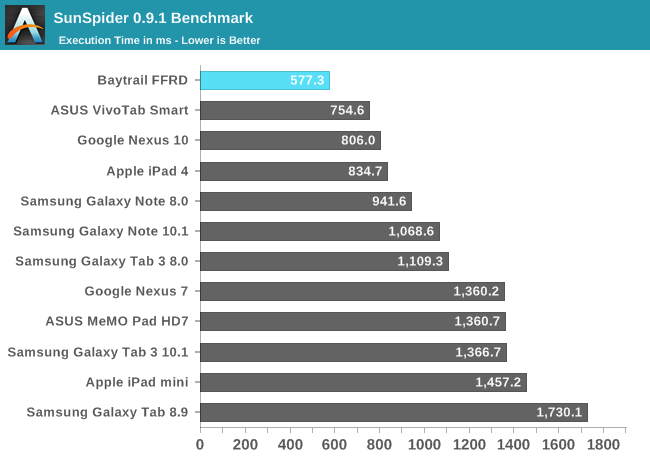
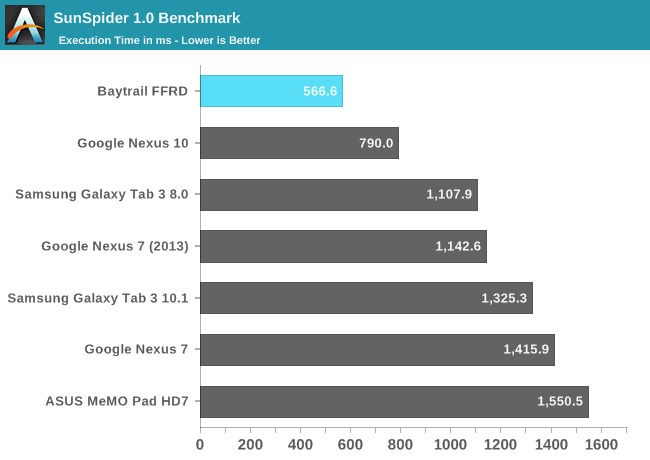
Sunspider has been a regular staple but in recent time has become an exercise in browser JavaScript engine optimization rather than actual performance. Nevertheless the FFRD takes the crown in both 1.0 and 0.9.1 (we have more tablet data from the 0.9.1 version so I replicated it here).
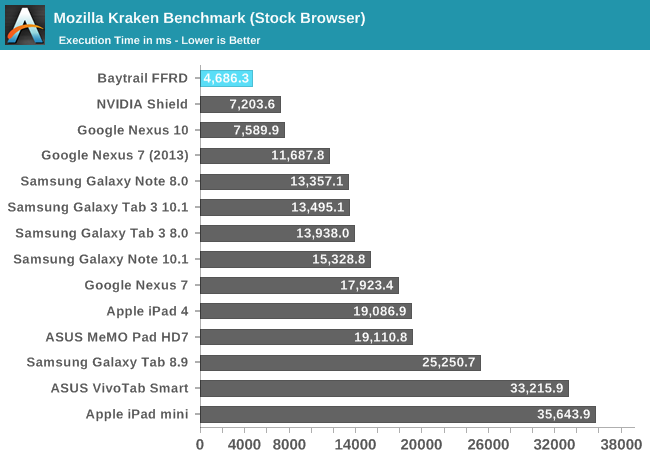
Kraken is another JavaScript benchmark which hasn’t quite been an optimization target everyone has gone after lately, and it’s also longer, which makes it a bit more reliable. Once again Bay Trail takes the crown here with notably faster JS engine performance.
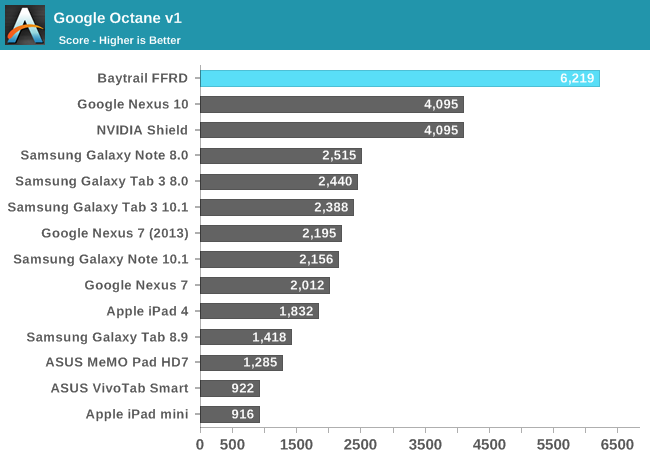
Google Octane is another JS test that isn’t quite as platform optimized yet, here there’s once again dominance by Bay Trail with just over a 50 percent higher score.
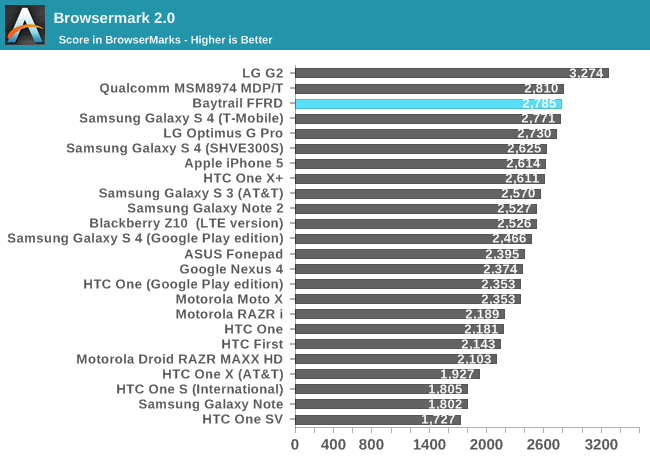
Browsermark has a combination of both JS tests and other web related performance metrics. Here the Bay Trail platform lags behind the 8974 based devices slightly. This isn’t a raw JavaScript benchmark again but rather a more holistic web browsing performance test, so it’s interesting to see Bay Trail a bit behind here.
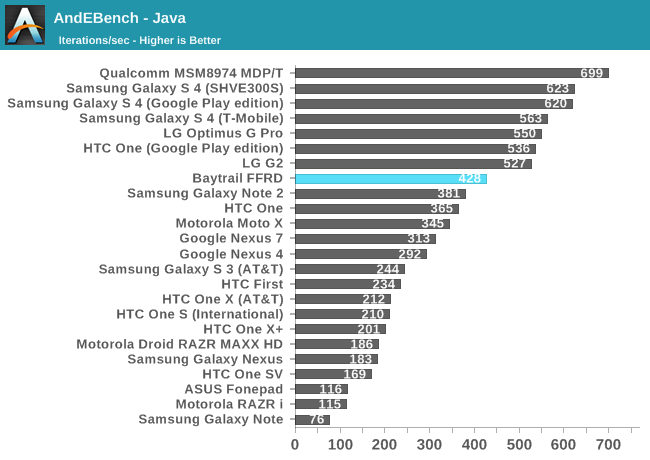

AndEBench is a combination native compiled microkernel benchmark (indicative of NDK application performance) that also runs a very similar workload atop Dalvik like a normal Android Java application. Here we can see what Intel was talking about when they said they have more work to do getting Dalvik working properly at dispatching threads to appropriate cores, hopefully the Java number will climb considerably. The native test also shows a lead over the competition.
GPU Performance
While Bay Trail clearly leads on the CPU side, its GPU performance is more middle of the road - at least among the higher end SoCs. In 3DMark Bay Trail's GPU performance is aided by the more CPU bound nature of the benchmark, but here Intel is able to beat the Snapdragon 600. Snapdragon 800 on the other hand pulls ahead by around 35%.
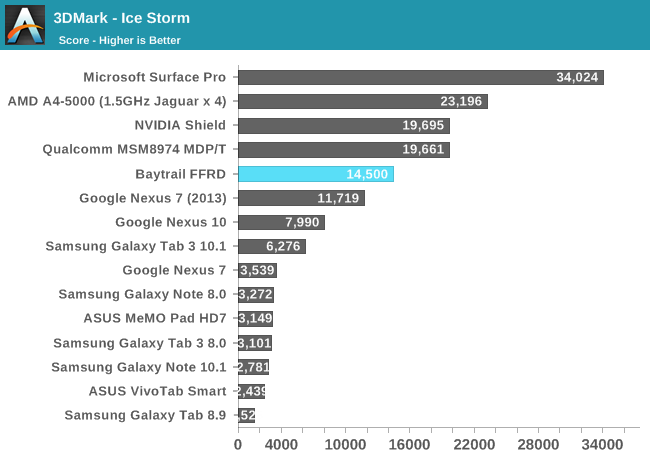
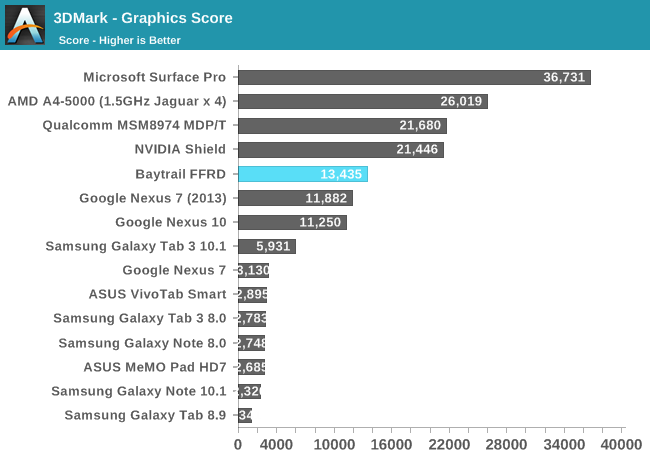
The 3DMark Physics test is effectively a CPU test, which once again plays to Bay Trail's strengths. Here it's faster than Snapdragon 800 and Cortex A15. Only Ivy Bridge is quicker in a tablet.
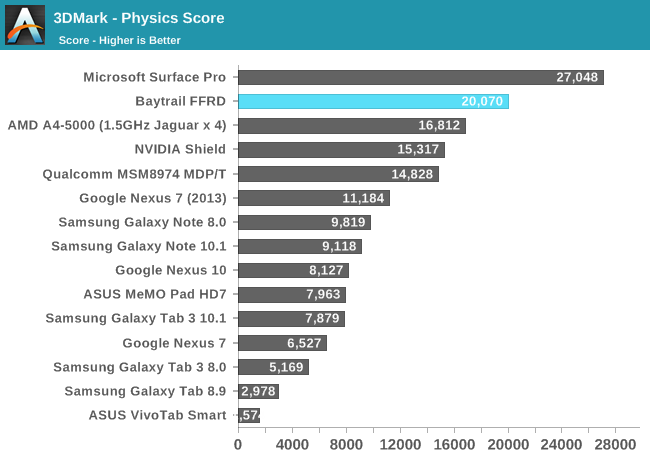
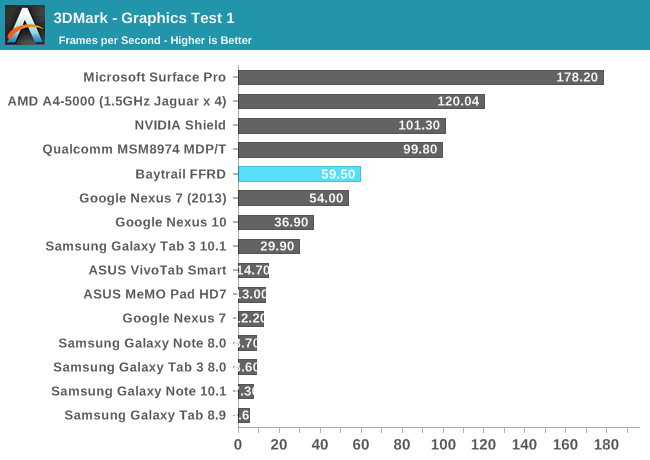
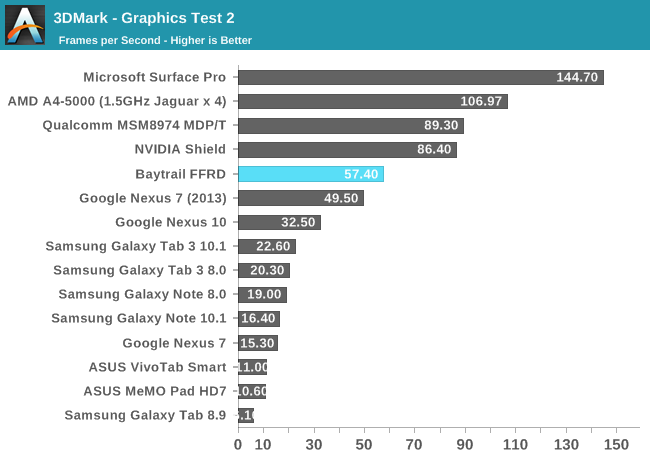
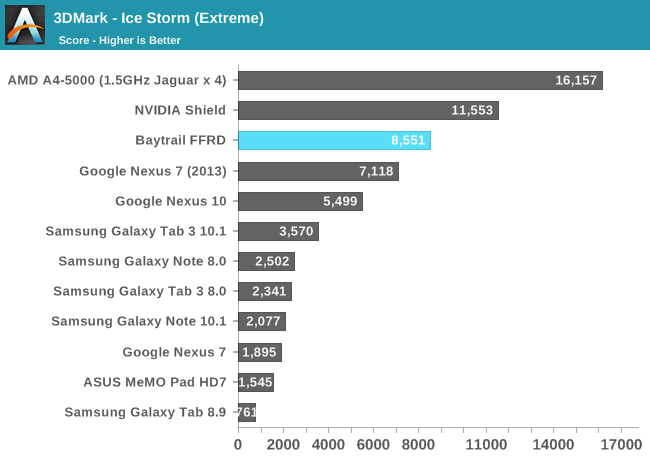
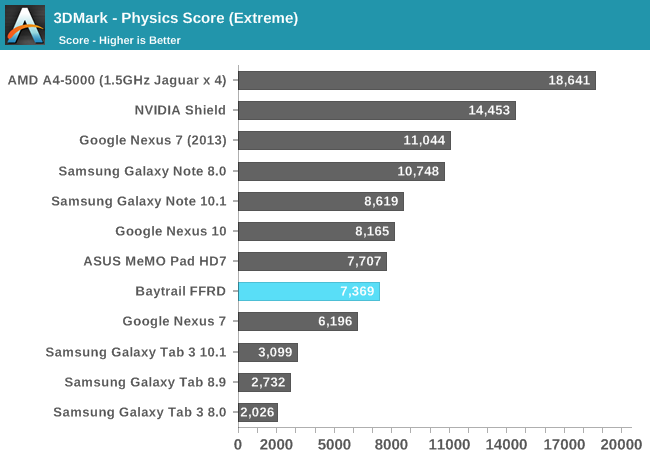
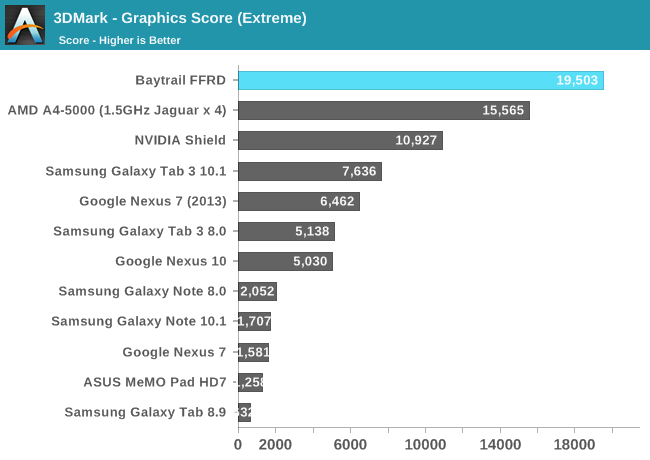
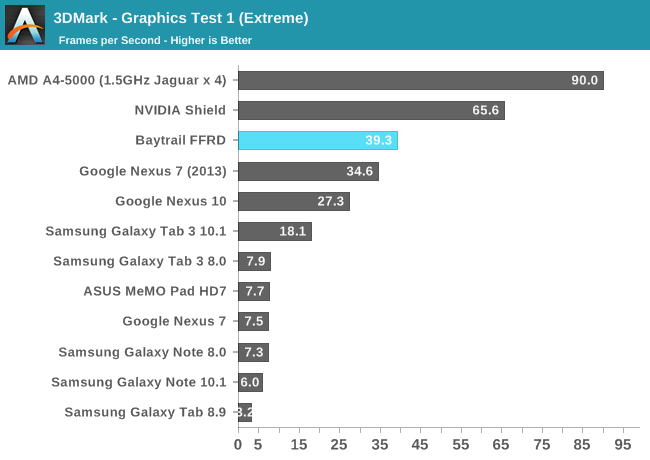
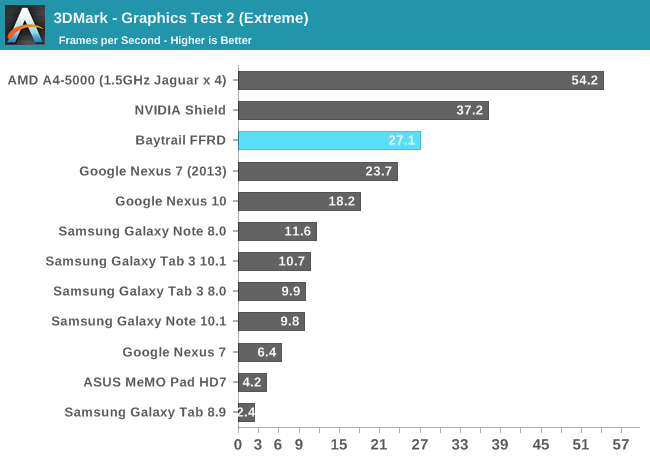
Basemark X
Basemark X is a bit more GPU bound than 3DMark, and we also have iOS data here so we can put Bay Trail's performance in better perspective. Here Bay Trail is a bit slower than the iPad 4, and clearly Tegra 4 and Snapdragon 800. Intel's GPU in Android is measurably quicker than Adreno 320/S600 though.
Bay Trail's onscreen performance is penalized by the FFRD's extremely high native resolution.

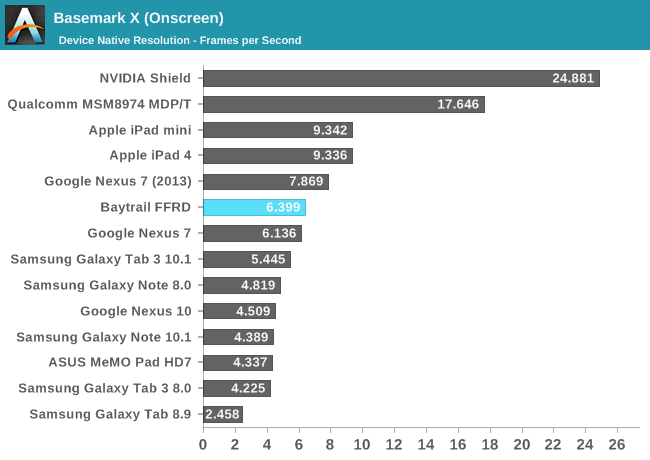
GLBenchmark 2.7
The more interested GLBenchmark numbers, T-Rex HD, show Bay Trail just behind the iPad 4 in performance. It's definitely not bad at all but clearly not industry leading.
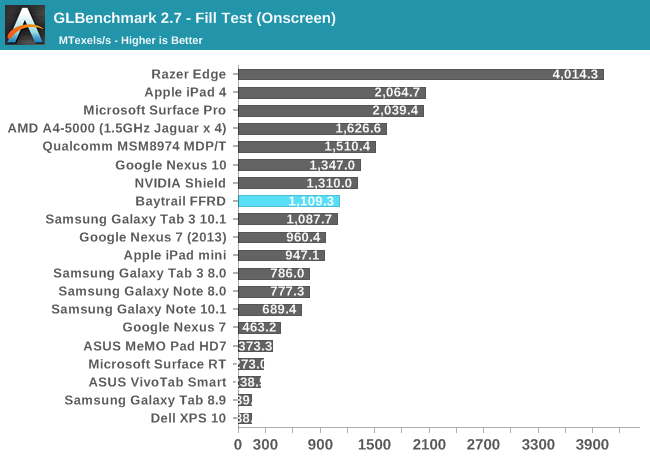
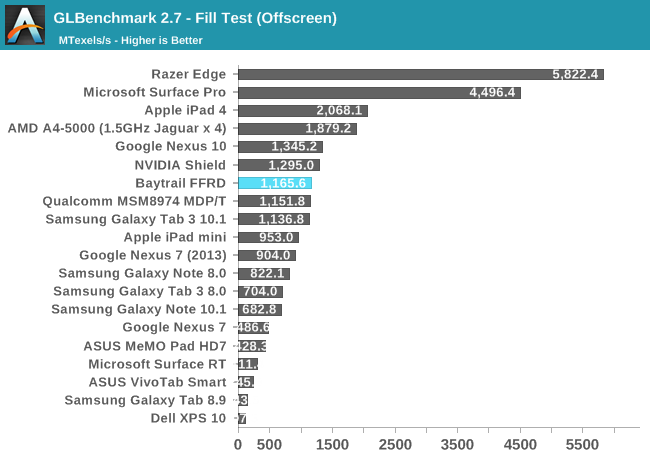
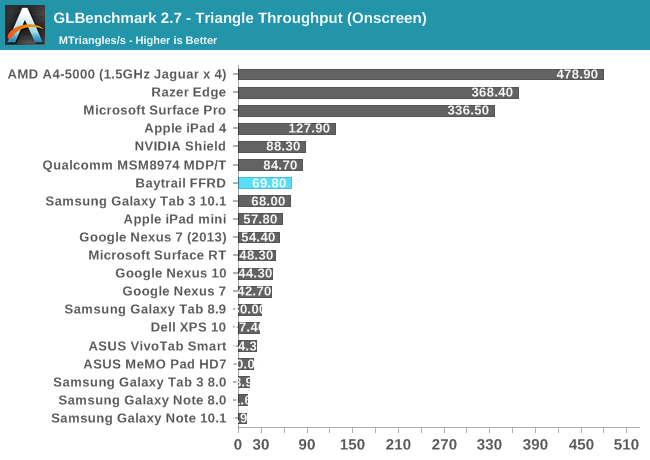
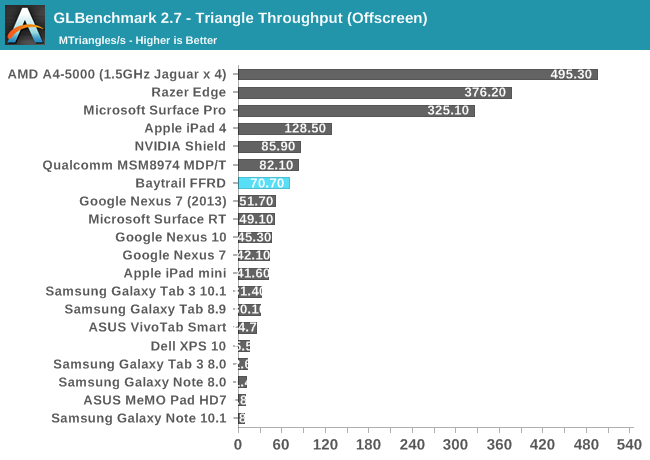
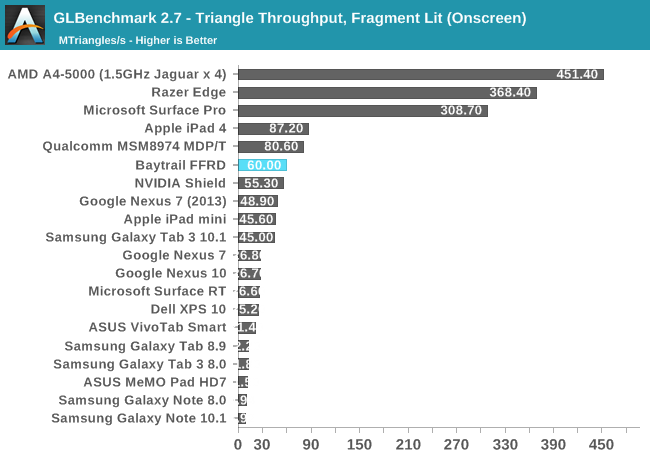
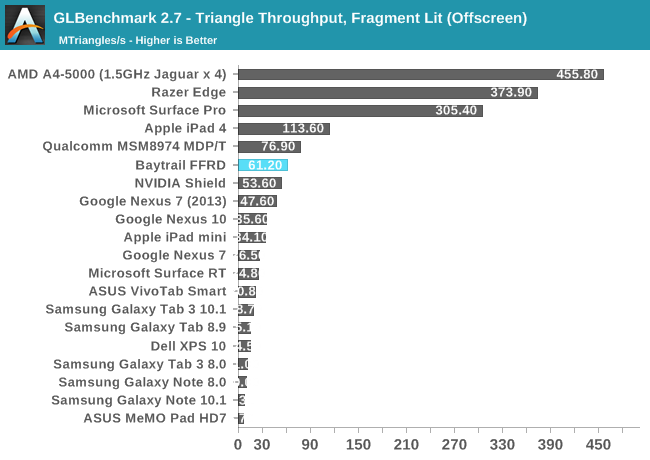
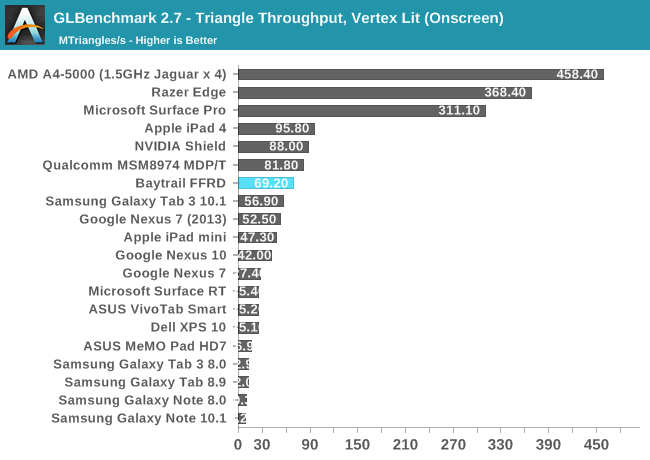
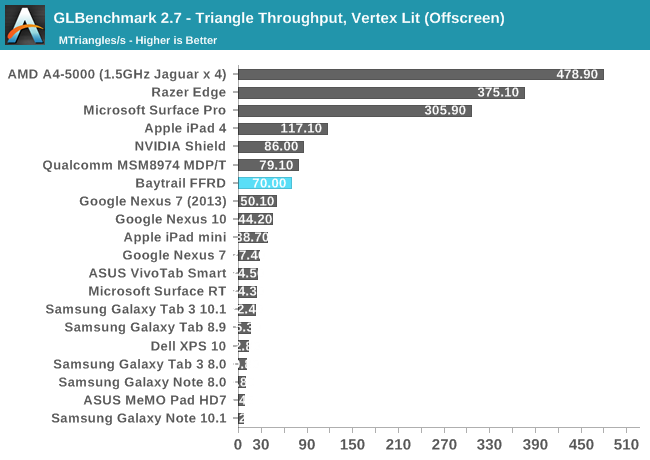
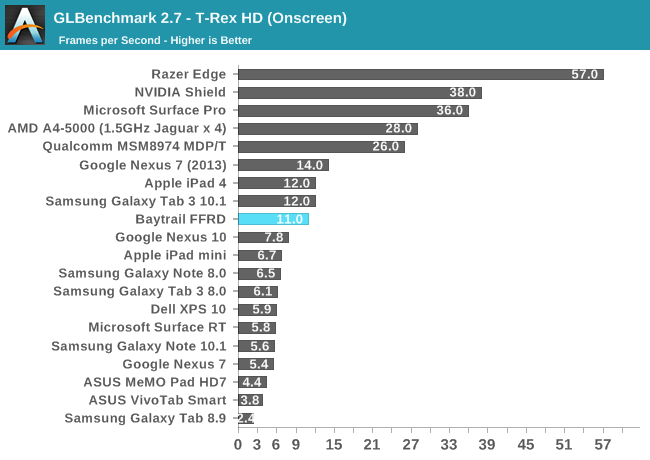
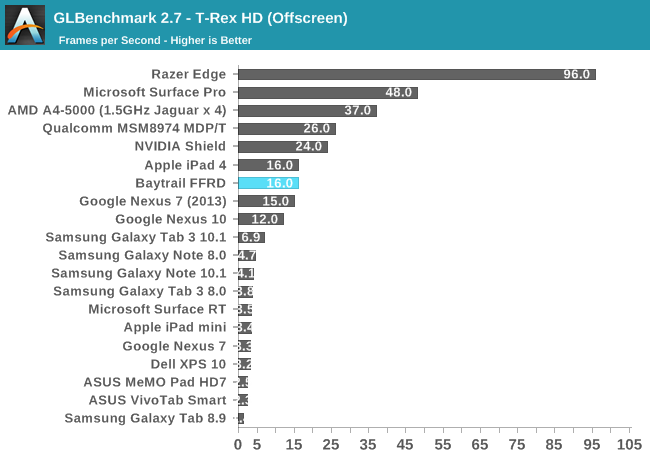
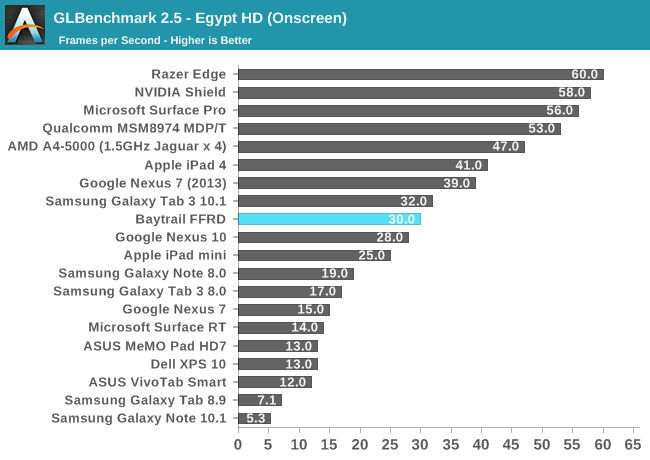
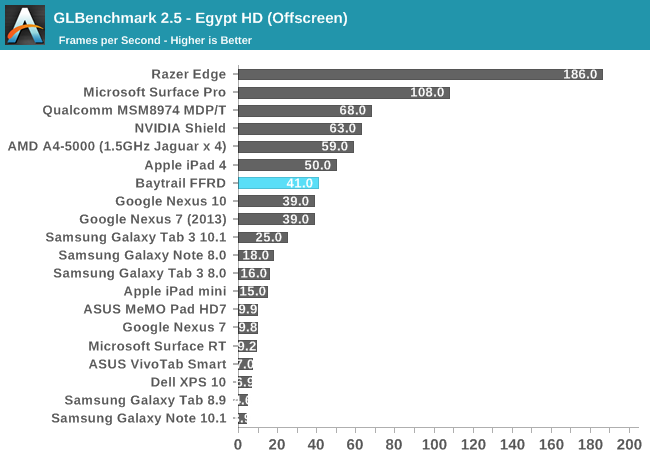
















190 Comments
View All Comments
Dentons - Wednesday, September 11, 2013 - link
Whether Intel's chips are "only" 50% more expensive or 100% more expensive, why would that motivate a move to Intel? What's the advantage? A 5% performance gain? That's not a motivator. Especially considering the considerable advantages of ARM. With ARM, tablet builders can purchase CPU's from a multitude of manufacturers. With X86, that competition would be non-existent.Were Intel to have a 50% or 100% performance advantage, some manufacturers might be enticed, at least for their higher end products, but that's not where we are. As things stand now, only those manufacturers needing X86 compatibility are likely to bite. The only need for X86 is Windows. So other than the handful of Android tablets that Intel pays to have built, all of these chips will go into Windows 8 machines. Likely 99% + of shipping volume.
This is a chip designed to prolong the WinTel duopoly. That is this chip's best case scenario. It's going to have almost no real-world uptake in Android and absolutely no uptake on iOS. Its intrusion into the mobile ecosystem will, at best be 5% to 10%.
This is small time.
rabidkevin - Friday, September 13, 2013 - link
"The only need for X86 is Windows."Last time I checked, x86/x64 is used for windows, linux, mac osx, ps4 and xbox one.
Dentons - Tuesday, September 17, 2013 - link
To clarify, I was referring to this specific chip, not X86 in general. Were I being overly precise, I'd have written "The only significant market need for this particular, mobile-specific, low-power X86 chip is Windows."It's hard to see any of the other markets you've mentioned needing, wanting, or using these chips. That's a massive problem for Intel, as right now, the tablet market is almost entirely iOS and Android. For iOS and Android, X86 compatibility is at worst a significant liability, at best, a completely unneeded expense.
It seems unlikely Intel will see much uptake with Apple or Android manufacturers. How else can Intel gain traction in the Tablet market if not with Windows? And that, as we know, requires the Microsoft tax, pricing Intel well out of the current tablet market.
Intel's in a tough spot. While they have finally released a chip with power / performance parity to ARM's latest, it may be 5 or 6 years too late.
Kidster3001 - Thursday, September 12, 2013 - link
All of your arguments apply to the Home PC market in 1980 where Intel had zero market share. What happened in the next decade?All of your arguments apply to the Server market in 1990 where Intel had zero market share. What happened in the next decade?
All of your arguments apply to the Supercomputer (HPC) market in 2000 where Intel had zero market share. What happened in the next decade?
I wouldn't be so quick to count Intel out in the long run.
ancientarcher - Friday, September 13, 2013 - link
I think the same thing that Intel did to the RISC based processors in the 1980s, 90s and 2000s will be done to it by ARM. Disruption from below, my friend.and what did happen - first you say the competition is cheap and low quality (on whatever metrics) and ignore it. then you say the same thing, but secretly tool up to compete (which takes a few years), in the meantime, the cheap but good-enough parts are improving much faster than you are. The reason you take time to compete is because you don't see much money there and by corporate style IRR calculations it doesn't make sense to compete. By the time you are ready to compete (which takes many years, 5-6 in the case of Intel), the erstwhile cheap and bad competition has become cheap and competitive and finally cheap and good, then better. Then you die.
Watch and see what happens to Intel in 3-4 years...
MyOpinionDoesNotMatter - Saturday, September 14, 2013 - link
Intel dead in 3-4 years??? I Hope ARM chip manufacturers take the Intel threat more seriously than you do. Intel have the resources and now (finally) the mobile focus to one day have a monopoly...for the sake of us consumers I hope ARM chips can remain competitive in the long run. Intel have caught up a lot in Bay Trail and this will make the next generation of chips very interesting. We may end up with a situation similar to Intel/AMD in high TDP chips....Intel for high performance mobile/tablets and ARM chips for the low end.jhoff80 - Wednesday, September 11, 2013 - link
I know that this is slightly off topic, but I was under the false impression that Connected Standby would be coming to 8.1 even on the architecture. Are there any plans whatsoever to bring that feature?It's not a huge deal, but it'd be nice for Skype calls or even for Windows 8.1's new "Alarms" app to have that support. It actually makes the idea of upgrading to a Haswell tablet from my Surface a bit less appealing.
zeo - Wednesday, September 11, 2013 - link
Connected Standby is supported and has been support, it's only new for Intel's higher end process but Haswell will bring that support to the Core processor... The ATOM SoCs already had it... It just requires both the OS, system firmware, and hardware support to work...If anything is off, like bad wifi drivers, then it won't work correctly...
jhoff80 - Thursday, September 12, 2013 - link
Well, first of all, that was supposed to say "I was under the false impression that Connected Standby would be coming to 8.1 even on the x64 architecture."Secondly, what I'm referring to is the quote from the article: "Although the core architecture is 64-bit in design, there will be no OS support for 64-bit Bay Trail at launch. Windows 8.1 with Connected Standby appears to still be 32-bit only"
I'm completely aware that it depends on every part of the chain and that support for it is now available in Haswell, but that doesn't do much if I can't use all of my 4 or even 8GB of RAM with that fancy new chip.
UNCjigga - Wednesday, September 11, 2013 - link
Sounds like the ideal platform for a sub-$200 Chromebook, but I'm still wary of Windows 8.1 performance.